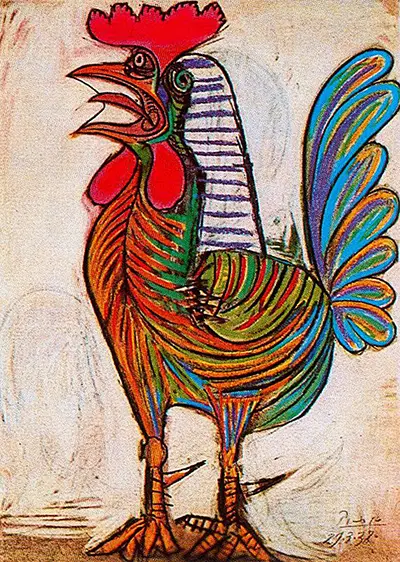A colourful, abstract, angular body with a jutting sharp head are lined by flowing feathers. Red and orange, green and blue vibrancy woven together like a tapestry to create a proud strutting cock.
It is widely believed that the Cock was representative of America, which had just entered into World War II. The red vibrancy of the Cock is breaking out of the picture, boiling over but somehow impotent in a parallel to the futility of war and its wasteful energy.
In keeping with the Picasso philosophy of looking at things with different eyes we note that both eyes of the cock are visible as if it were the flat face of a Dover Sole.
It is believed that Picasso was asked about the meaning of the Cock and he replied, 'there have always been cocks, but like everything else in life we must discover them - cocks have always been seen but never as well as in American weather vanes".
Picasso’s interest in cockerels begun in 1931 in his sculpture studio, Chateau de Boisgeloup. Between 1931 and 1934 he produced a number of his most important sculptures including three versions of a cockerel. The sculptures were characterised by spiky elongated features and captured the proud strength of the bird. It is thought that his move to the country and his contact with the birds triggered a desire and fascination to interpret the cockerel’s mannerisms.
In the painting ‘The Cock of the Liberation’ painted in 1944 we see Picasso return to the theme of the cockerel. Once again we can see that world events and the end of World War II had not been lost on the artist. The picture features a dominant cock who stands as a symbol of French pride and liberation from the occupying Nazi forces.
While Picasso carried on living and working in France during the Nazi occupation he, like many celebrity cultural artists of the time, were left alone, as the occupying regime preferred to try and court intellectuals and those who might exert political influence.
He produced a number of political commentary pieces during this period such as 'The Charnel House' 1945 and also 'Monument to the Spaniards who Died for France' 1945–7 were in remembrance of his fellow Spanish nationals who lost their lives during the war.
Pablo Picasso became renowned as a painter and sculptor. His passion for art manifested at an early age and he was accepted into the School of Fine Arts at thirteen years old passing the usual one month entrance criteria in just one week.
Best known and associated with the Cubist movement, he was a major contributor to new modern movements including Surrealism and Symbolism. Picasso was a prolific poet, writing over 300 poems between 1935 and 1959. His bohemian style and charisma fuelled his work and influenced our notions of form and space in the modern world.
Picasso’s most famous work includes; Guernica (1937) and Les Demoiselles d'Avignon (1907) but his real legacy was perhaps how an artist can transcend paintings as a two dimensional form and influence how we character, perceive and shape our own architecture.
Picasso passed away in 1973, his final words, “Drink to me, drink to my health, you know I can’t drink anymore.”

